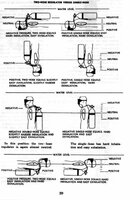This is an often-debated point; if you search you'll find lots of threads about it. Some very knowledgeable people, (Luis in particular) argue that it is the difference in average lung depth and regulator depth that determines cracking effort. Personally I believe that geometry in the 2nd stage case has more to do with it, but it's not about the orientation of the diaphragm. I know this for a fact because the D series and earlier SP center-balanced valve 2nd stages have the diaphragm orientation reversed and yet they act almost exactly the same in the water.
I think that the relative depth between the diaphragm/lever contact point and the exit of the mouthpiece is very important in cracking effort. In most 2nd stages, there's at least a 1" difference between these two points; face down, the mouthpiece is shallower; face up, it's deeper. So that would account for 2" overall difference between these two positions. 2" is a lot of cracking effort.
If you've ever used a double hose regulator, you know that moving the mouthpiece up to a shallower depth than the can (which is the 2nd stage) causes it to freeflow, moving it deeper causes cracking effort to increase sharply. The orientation of both the mouthpiece and the can relative to the surface makes no difference in this behavior.
Since the exit of the mouthpiece and the lungs are all part of the same breathing loop, I'm willing to concede that lung depth has some influence over WOB, but certainly not entirely. Try breathing on a conventional 2nd stage while vertical in the water, head towards the surface but looking parallel to the surface, then try up-side down, feet towards the surface but still looking horizontally. There is some difference in cracking effort, but not nearly as much as the face down/face up comparison. Yet, feet up/feet down represents by far the biggest difference in lung/regulator depth.




